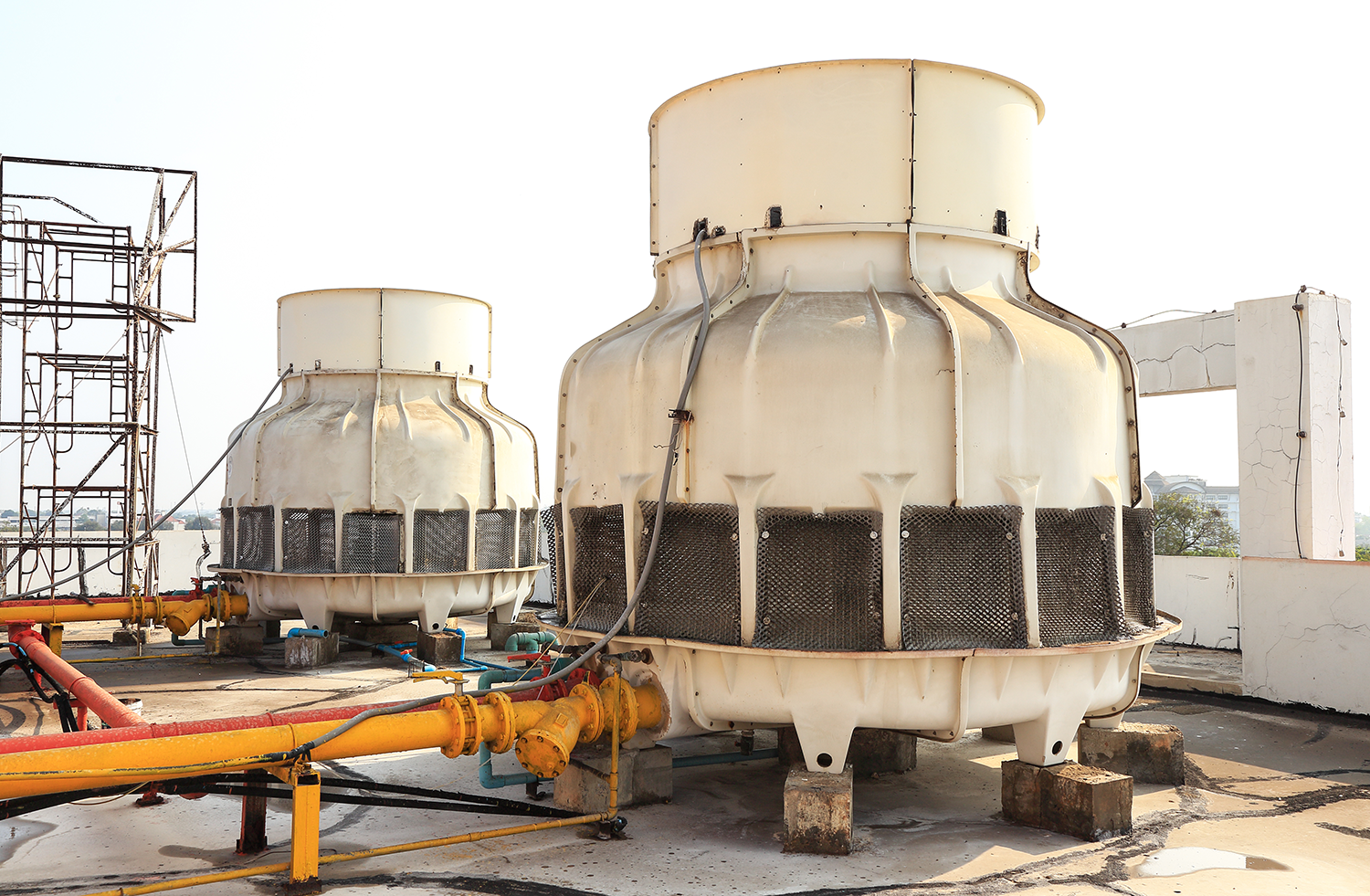Cooling Tower Materials – Metal vs. Plastic

Cooling towers are essential components in most commercial HVAC systems. Like any HVAC component, cooling towers have seen their share of design iterations over time. Among changes in fan design and size offerings, manufacturers have also changed up the material used. Historically, these have been crafted from metal. However, in recent years, a new option has gained popularity. Plastic – but not just any plastic. Manufacturers began to create cooling towers from Advanced High-Density polyethylene (HDPE), and their popularity continues to grow. So, which is the better option – metal or plastic?
Traditional Metal Cooling Towers
If you’ve ever looked up at the rooftop of a large commercial or manufacturing building, you probably noticed some pretty large steel cooling towers working hard. You may have even heard them before you saw them. Metal cooling towers can help keep large HVAC systems running efficiently by acting as a heat exchanger that used water to cool the hot air. If properly maintained, these towers can last years. Those made from galvanized steel are likely to last about 10 years. Opting for stainless steel can double that lifespan, but that comes with a cost. Stainless steel cooling towers are much more expensive, and still, require the same type of maintenance.
Scaling and Buildup
Because of the amount of water passing through a cooling tower, the metal is vulnerable to buildups of algae. Additionally, bacteria such as legionella often make themselves at home in the towers because of their warm and wet atmosphere. Part of regular maintenance means addressing these issues to reduce safety concerns. While several options are available to treat and prevent bacteria growth, the most common choice is a chemical treatment. These are often expensive, but must be done to keep the system running safely for those within the building.
Risk of Corrosion
With metal, towers often experience corrosion over time. The risk of this happening increases when the tower is exposed to harsh water treatment chemicals, soft water, or certain weather conditions. Corrosion is not just unsightly either. It can lead to leaks in the cooling tower, which decreases its efficiency and can be a hassle to contain and clean up. Many times, it is the constant need for repair in metal cooling towers that lead building owners to look into alternative material options, such as engineered plastic.
HDPE Cooling Towers
Can plastic compete with the efficiency and lifespan of metal cooling towers, and if so – are there any added benefits from making the switch? The most obvious benefit is HDPE’s durability and resistance to damage from chemical use. Even harsh and acidic water treatments don’t lead to corrosion with the plastic, meaning far fewer (if any) leaks. A lack of rust also leads to a longer lifespan of the tower.
Many of these water treatments gear themselves towards fighting off bacteria, such as legionella. However, scientists have realized that they can create an HDPE that incorporates antimicrobial resins in its structure. These resins shield the tower from bacteria growth that can be dangerous or deadly to those who breathe it in.
How do HDPE towers stack up in terms of installation? Because of the material, the towers are often much thicker than those made from metal. However, they remain very lightweight, making for easy and quick installation.
Cost and Efficiency in Plastic Cooling Towers
Along with safety, one of the top concerns of building owners when it comes to their HVAC system is cost. This not only includes upfront costs, but also the cost of operation, which can vary greatly depending on system efficiency. The HDPE towers are often less expensive to install, but the real savings comes from their efficiency and lifespan. These towers tend to maximize cooling, as their direct-drive fans and staged design make it so that not all fans run non-stop.
Another area of savings many building owners see is the lack of maintenance needed in comparison to metal towers. Plastic towers are engineered in one large piece, meaning there are no seams, joints, panels, etc. Because of this design, much of the regular maintenance, such as tightening joints and caulking the seams become non-existent.
Finally, another area of savings that is important to note comes in warranty length. Manufacturers of plastic cooling towers tend to offer a longer warranty period, meaning that if an issue does arise down the road – the chances of the manufacturer’s warranty covering it are far stronger.
Plastic vs. Metal – The Best Option
While the benefits of an HDPE cooling tower seem pretty convincing, each building is unique in its structure, use, and needs in an HVAC system. So, there is no blanket answer to which type of cooling tower material is best for all situations. In some situations, additional materials like fiberglass also need to be considered. When examining the benefits of each material type, it’s crucial to invite the opinion of an expert in the field. At Cooling Tower Experts, we have spent years gathering knowledge and expertise around all types of cooling towers. We can help assess your unique situation and generate a solution that will maximize both safety and efficiency.
Whether your tower requires repair or you are looking to install a new or upgraded system, we can help. Contact us today for a personalized assessment of your existing cooling towers!